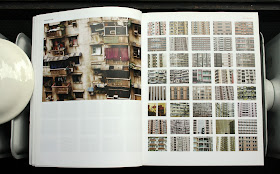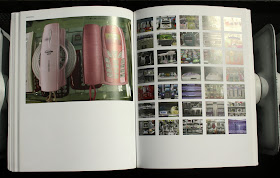China Daily Life
2006
Introduction China Daily Life by Charlie Koolhaas:
Reineke Otten is both an artist and a social scientist. She is an artist, because her photos capture the strange and inarticulable beauty of everyday life. And a scientist, because her goal is not merely to capture beauty, but also to assemble fragments in a way that demonstrates patterns and orders. Taking a highly structural approach, Reineke’s photography is a research method for a visual sociology. She begins her inquiries from the bottom up, observing the smallest of details and social interactions and, in using these, she suggests how larger-scale institutions operate around them. Her method intensifies a multiplicity of social relations and interactions. Reineke calls her approach Streetology:
Reineke Otten is both an artist and a social scientist. She is an artist, because her photos capture the strange and inarticulable beauty of everyday life. And a scientist, because her goal is not merely to capture beauty, but also to assemble fragments in a way that demonstrates patterns and orders. Taking a highly structural approach, Reineke’s photography is a research method for a visual sociology. She begins her inquiries from the bottom up, observing the smallest of details and social interactions and, in using these, she suggests how larger-scale institutions operate around them. Her method intensifies a multiplicity of social relations and interactions. Reineke calls her approach Streetology:
“I divide the visual make up of the street into hundreds of different categories and divide these images into scales. Using photography I am making a street inventory or break down. I am part of this new digital generation, who are making important documents of this century.”
- Reineke Otten
Temporary like an Ikea Catalogue
So what does it mean to be part of the digital generation? In some way it is to share the frantic need to record as a way of absorbing. The digital generation are making massive inventories of ‘everyday life’ around the world; Otten’s work comprises a fragment of this effort. It is frantic and obsessive -a demonstration of the fear that things are changing before we even have time to witness the moment or understand what’s going on. Everything is documented so that It can be digested at a later date. The digital generation are observers rather than participants, they record before they experience, and every exciting moment that isnt recorded is considered a missed opportunity.
“The quickness of the digital photography matches the rapid changes of the city.
door Marlou VrijsenThe Chinese Photobook
PARR, MARTIN / WASSINK, LUNDGREN ISBN 10: 1597112283 / ISBN 13: 9781597112284
Publisher/Verlag: Thames & Hudson | From the 1900s to the Present | In the last decade there has been a major reappraisal of the role and status of the photobook within the history of photography. Newly revised histories of photography as recorded via the photobook have added enormously to our understanding of the mediums culture, particularly in places that are often marginalized, such as Latin America and Africa. However, until now, only a handful of Chinese books have made it onto historians short lists. Yet China has a fascinating history of photobook publishing, and The Chinese Photobook will reveal for the first time the richness and diversity of this heritage. This deluxe, lavishly produced volume is based on a collection compiled by Martin Parr and Beijing- and London-based Dutch photographer team WassinkLundgren. And while the collection was inspired initially by Parrs interest in propaganda books and in finding key works of socialist realist photography from the early days of the Communist Party and the Cultural Revolution era, the selection of books includes key volumes published as early as 1900, as well as contemporary volumes by emerging Chinese photographers. | Format: Hardback | Language/Sprache: english | 448 pp.
THE MAKING OF URBAN DAILY LIFE BY REINEKE OTTENAls ik op stedentrip ga verzamel ik alle bonnetjes, kaartjes en verpakkingen die ik tegen kom, alles bewaar ik. Mijn manier om een nieuwe stad in kaart te brengen en mijn herinneringen te ordenen. Er zijn ook fotografen die de stad willen ordenen, sommigen gebruiken daarvoor herinneringen of emoties, anderen proberen een objectief standpunt in te nemen, maar allemaal gaan ze de stad in en zetten alles op beeld wat ze tegenkomen.
Frits Weeda (1939, Amsterdam) legde obsessief Amsterdam vast en fotografie werd letterlijk een verslaving en hem. Foto's van de verkrotting van oude wijken, van vervuiling, autowrakken en armoede. Maar ook foto's van kinderen en markttaferelen. Het verhaal van Amsterdam in wederopbouw met ook de schaduwkanten, want hoe dieper Weeda wegzakte, hoe donkerder zijn foto's werden. Na zeven jaar krijgt hij allerlei hallucinaties en de dokters constateren dat hij zich inbeeldt dat hij kunstenaar is. Weeda moet letterlijk afkicken en zoals een alcoholist nooit meer een borrel neemt, zo raakt Frits Weeda geen camera meer aan. Soms doet hij de gordijnen dicht. Niet dat er buiten zoveel bijzonders gebeurt, maar hij kan niet stoppen met kijken. Een andere keer loopt hij uren door de stad en kan daarna zeggen dat hij zonder fototoestel drie goede foto's heeft gemaakt met zijn ogen.
Reineke Otten (1979, de Bilt) lijkt op dezelfde manier met haar onderwerpen om te gaan, maar waar Weeda op jacht gaat naar die ene mooie foto, knipt Otten met haar digitale camera gewoon door. Ze is letterlijk bezig met het catagoriseren van steden. 'It's about the time now; within a few years it will be outdated. In China in one month there can be 3 new owners in a shop. Complete areas are raised and cut down again'. Haar boek China Daily Life is geordend volgens de fotomappen op haar computer. Per twee pagina's een map met titels als 'offers for sale', 'friendship', 'traditional kitchen' en 'laundry'.
Door zo in te zoomen op details van een stad probeert Otten een universele taal te ontdekken. 'Every city around the world has many of the same ingredients but how these elements interact tells us about the cities unique character. Using the same method in different cities will eventually show similarities through their differences and differences through their similarities'.
Ook Ed van der Elsken (1925 -1990, Amsterdam) had de stad als onderwerp, maar hij was niet op zoek naar een universele taal. Hij zocht naar het leven in de stad en wilde vooral zijn eigen taal spreken. Waar hij woede over voelde of wat hij gepassioneerd liefhad zag hij op straat en in de stad. Dat wilde hij laten zien en de mensen werden acteurs die het toneelstuk uitbeeldden dat hij had willen schrijven. Op zoek naar dat unieke moment waar de intensiteit van het leven vanaf spat. De stad vol met pijn, verdriet, lusten, verlangens en wanhoop. Het liefst had van der Elsken dan ook een cameraatje met microfoontje in zijn hoofd laten bouwen om 24 uur per dag dat vast te leggen wat zijn oog ziet en dat te becommentariëren.
Aglaia Konrad (1960, Salzburg) neemt juist afstand van de stad en kijkt naar stedelijke structuren. Altijd buiten, zonder detaillering, zonder focuspunt. In haar boek geven steden de foto´s een naam, maar eigenlijk doen de plaatsen er niet toe. De structuren en gebouwen worden afgesneden en daardoor lijkt het alsof de foto's samen smelten tot één grote stad. De mens heeft een tweede natuur gecreëerd, opgebouwd uit muren, vlakken en lijnen. Uit de context gehaald verwijzen de gebouwen niet naar een sociale, politieke of historische werkelijkheid. Nergens wordt het persoonlijk en nergens kun volgt identificatie. Als een ruimtewezen bekijk je de aarde en verbaas je je over de ruimtes en structuren die zijn gecreëerd. In de tentoonstellingen creëert Konrad nieuwe dimensies door haar foto's in en over elkaar te zetten. Steden in steden uitgespreid over de muren van de tentoonstellingsruimte. Haar visuele werelden zijn tijdloos en het is aan de bezoeker om een eigen plek te vinden, zoals we ook constant proberen in de echte wereld.
Ik gebruik daar mijn verzamelmanie voor, fotografen gebruiken hun fototoestel. Door gericht de werkelijkheid in te kijken, komt deze misschien minder hard aan. Toch lijkt het me voor de fotograaf vermoeiend. Ik hoef alleen maar fysiek bewijs te bewaren, die bonnetjes krijg ik gratis en voor niets en als ik er geen krijg is het ook goed. Maar een fotograaf moet constant kijken. Op zoek naar beelden blijft de fotograaf foto's nemen, of hij nou een fototoestel bij zich heeft of niet.







































Geen opmerkingen:
Een reactie posten